Understanding Alkaline Hydrolysis Cremation Costs in 2025
The average alkaline hydrolysis cremation cost ranges from $1,295 to $4,600 nationwide, with a typical price around $2,500. This eco-friendly alternative costs approximately $500-900 more than traditional flame cremation ($1,600 average) but remains significantly less expensive than conventional burial ($7,000-$12,000).
| Disposition Method | National Average Cost | Typical Range |
|---|---|---|
| Alkaline Hydrolysis | $2,500 | $1,295-$4,600 |
| Flame Cremation | $1,600 | $1,100-$2,000 |
| Traditional Burial | $7,848 | $7,000-$12,000 |
When Archbishop Desmond Tutu chose water cremation for his final disposition in 2022, he spotlighted what many funeral professionals now recognize as the future of eco-friendly disposition. As one funeral director aptly described it, alkaline hydrolysis feels like "putting grannie in a warm bath rather than a hot fire" – a gentler approach that's gaining traction despite its higher price point.
Why the higher cost? The specialized equipment for alkaline hydrolysis runs between $180,000-$270,000 (compared to $130,000 for flame cremation machines), and limited availability in just 17 states with operational facilities drives up pricing. Most affordable states include Missouri and Washington (under $1,000 in some facilities), while California and Vermont represent premium markets ($3,500-$4,600).
I'm Mortuary Cooler, a national supplier of mortuary equipment who has tracked alkaline hydrolysis cremation cost trends across all operational states while helping funeral homes implement this technology. My experience with equipment installation and regulatory compliance gives me unique insight into why these costs vary so dramatically by region.
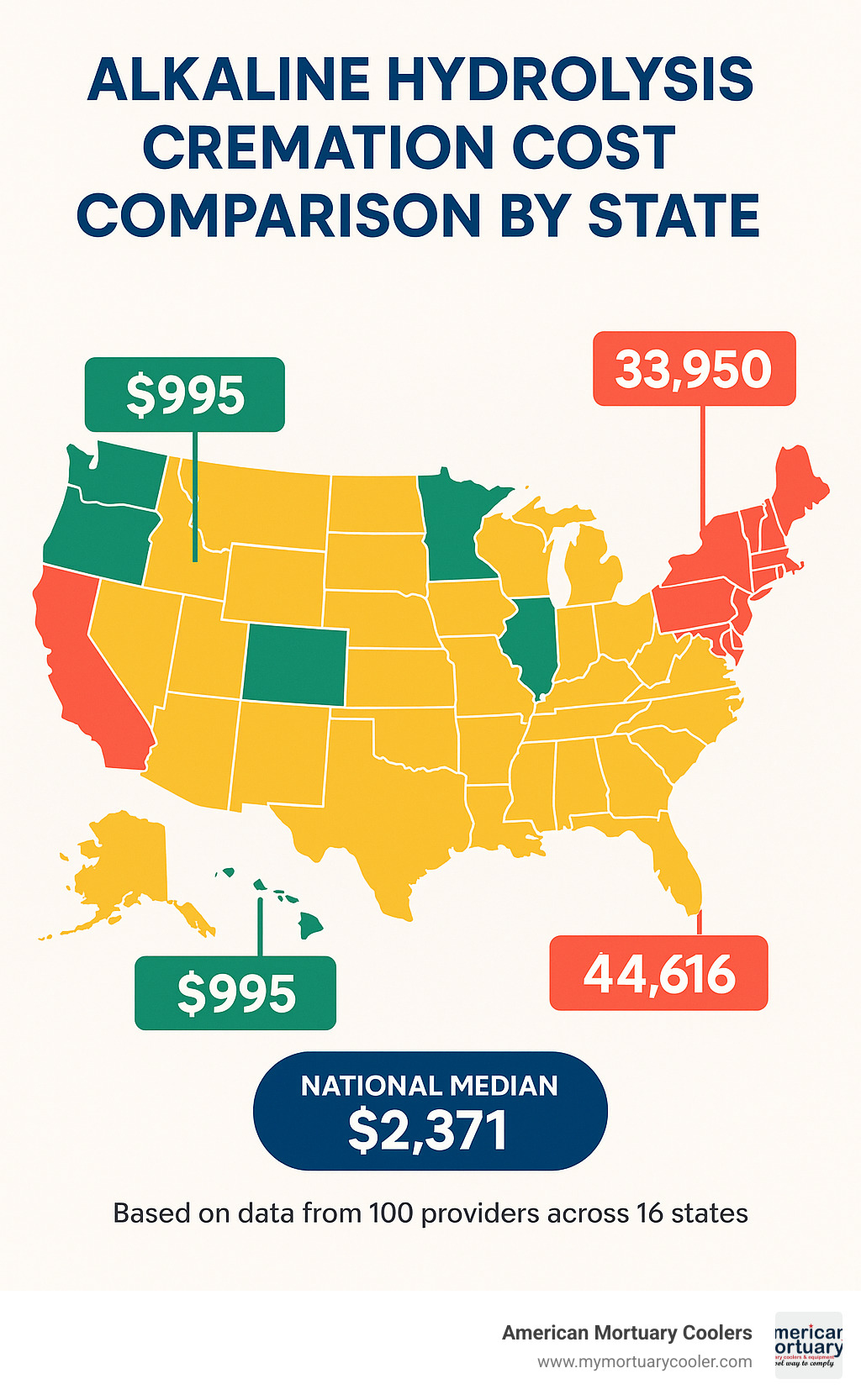
Know your alkaline hydrolysis cremation cost terms:
- Eco-friendly funeral options
- how do you get cremated by water
- is water cremation legal in california
How Alkaline Hydrolysis (Aquamation) Works & Why It's Considered "Green"
Ever wondered what happens during a "water cremation?" Alkaline hydrolysis—also called aquamation, bio-cremation, or water cremation—is essentially nature's decomposition process on fast-forward. Instead of flames, it uses a gentle bath of water and alkaline solution to return a body to its basic elements.
The process begins quite simply. The body is placed in a stainless steel vessel (think of it as a specialized chamber) filled with a solution that's 95% water and 5% potassium hydroxide or sodium hydroxide. Unlike the intense inferno of flame cremation, aquamation works at a much cooler temperature—between 199°F and 302°F, similar to what you'd use for slow-cooking a roast. Some systems gently circulate this warm solution, while others apply slight pressure.
Over the next 6-8 hours (though some older systems might take up to 20 hours), something remarkable happens. The combination of warm water, alkalinity, and gentle heat breaks down all organic material except bone. It's like watching months of natural decomposition happen in just hours, as tissues dissolve into their basic building blocks—amino acids, peptides, sugars, and salts.
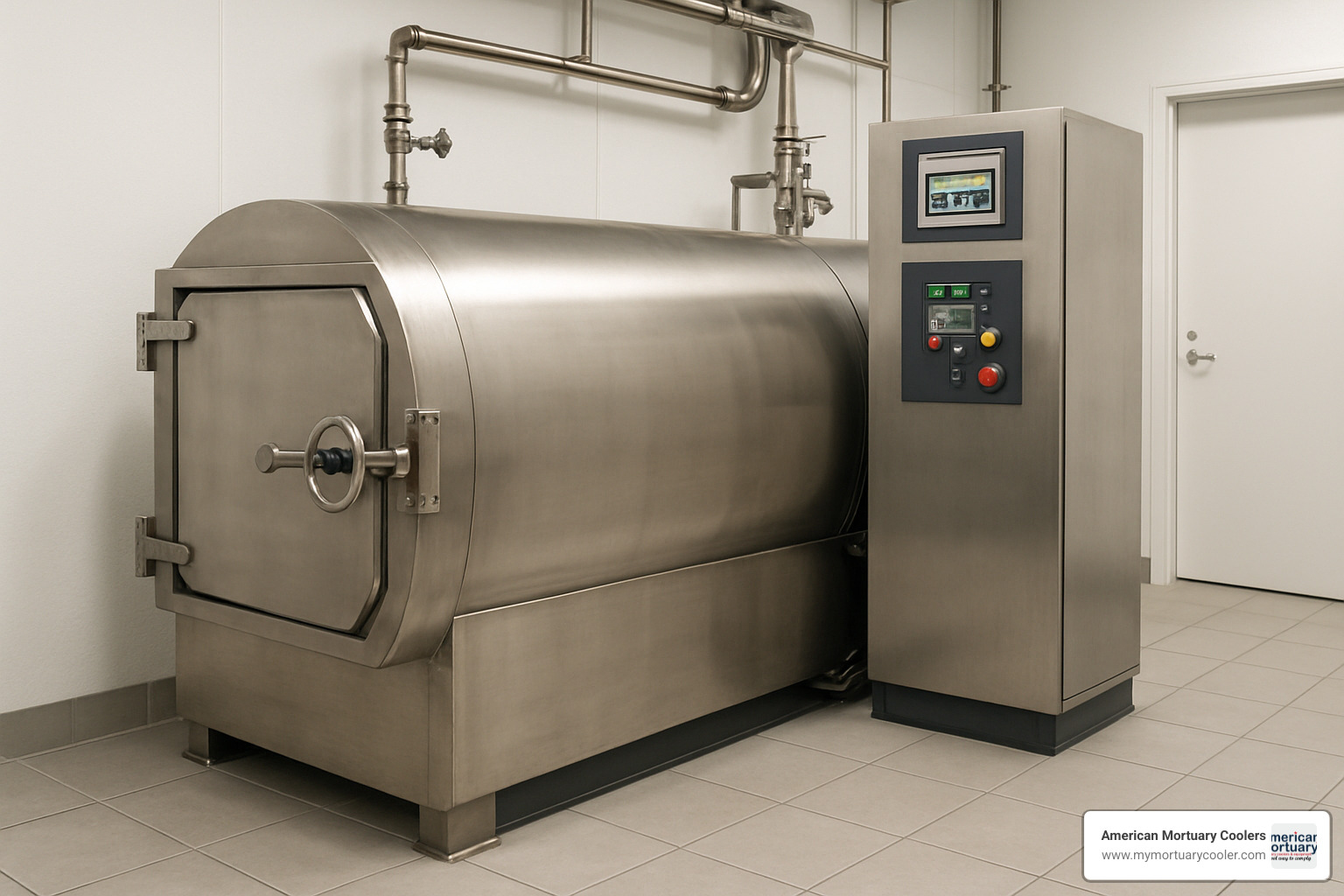
When the cycle completes, what remains is quite beautiful—pure white bone fragments made of calcium phosphate. These are dried and processed into a fine powder that families receive. Many are surprised to learn these remains are typically whiter than traditional cremation ashes, which often have a grayish appearance from combustion. The liquid effluent is completely sterile, containing no DNA or tissue, and safely returns to the water cycle through standard wastewater treatment.
Water vs. Fire: Technical Breakdown
The differences between water and flame cremation go beyond just wet versus dry. While flame cremation operates at a scorching 1,400-1,800°F, aquamation's gentle bath stays between 199-302°F—less than the temperature of boiling water in some cases.
Time is another factor. Flame cremation typically completes in 2-3 hours, while aquamation's more gentle approach takes 6-8 hours in modern systems (older or lower-temperature systems might need up to 16-20 hours).
The chemistry is fascinating too. Aquamation begins at a highly alkaline pH around 14, gradually shifting to 10-11 as tissues break down. This mimics natural hydrolysis but speeds it up significantly.
One practical benefit many families appreciate: pacemakers and medical implants don't need removal before aquamation since they won't explode as they would in flame cremation. These devices remain intact and can be recovered afterward for recycling—a small but meaningful environmental bonus.
The remains themselves are different too. Aquamation typically produces 20-30% more remains than flame cremation, and they're distinctly whiter since they don't contain carbon from combustion.
Environmental Savings at a Glance
The environmental benefits of alkaline hydrolysis are what draw many families to choose this option despite the higher alkaline hydrolysis cremation cost:
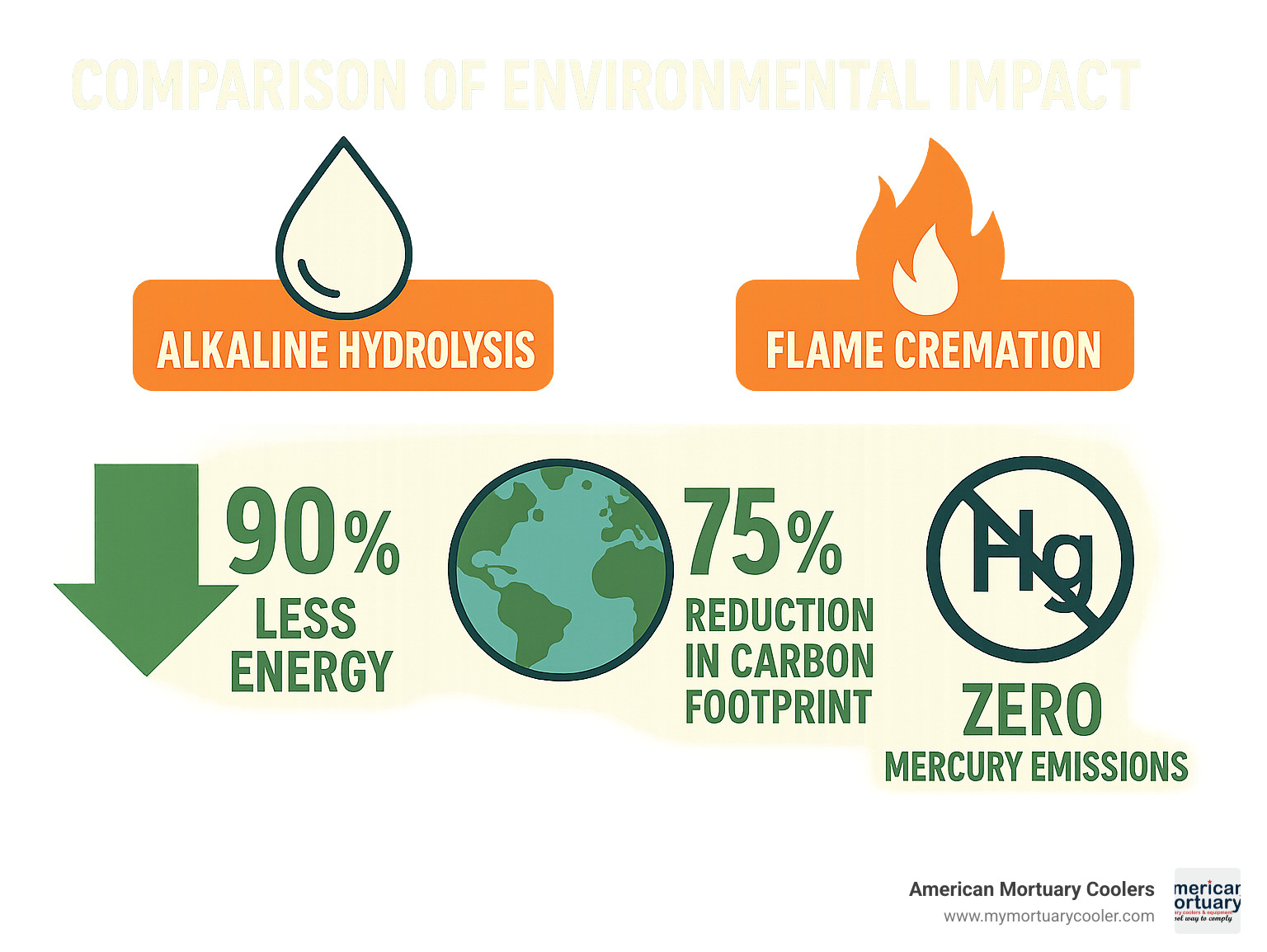
The numbers tell a compelling story. Aquamation uses just 10% of the energy required for flame cremation and has a 75% lower carbon footprint. While traditional cremation consumes about 92 cubic meters of natural gas, aquamation needs just 7. Electricity usage drops from 29 kWh to around 9 kWh.
Despite being water-based, the process is surprisingly efficient with water—using about 300 gallons, less than an average household consumes daily. And perhaps most importantly, there's what doesn't happen during aquamation: no combustion of fossil fuels, no release of mercury from dental fillings into the air, and no emission of greenhouse gases.
As scientific research on environmental impact continues to demonstrate, water-based cremation represents one of the gentlest ways to care for both our loved ones and our planet simultaneously. For families concerned about their environmental legacy, these benefits often outweigh the additional cost of choosing this newer technology.
Alkaline Hydrolysis Cremation Cost: National Averages & Side-By-Side Comparisons
When families ask me about alkaline hydrolysis cremation cost, I always start with the big picture. Looking at data from 100 providers across 16 states, you can expect to pay around $2,593 on average nationwide, with the median price sitting at $2,371.
Yes, that's typically $500-900 more than you'd pay for traditional flame cremation in most areas. But here's the good news – compared to conventional burial's national average of $7,848, aquamation offers substantial savings while being gentler on our planet.
Let me break down what you're actually paying for with each option:
| Service Component | Alkaline Hydrolysis | Flame Cremation | Traditional Burial |
|---|---|---|---|
| Basic Service Fee | Included | Included | $2,195 |
| Transport/Removal | Included | Included | $350 |
| Process/Cremation Fee | $2,000-$3,500 | $1,500-$2,000 | N/A |
| Casket/Container | Shroud ($100-$200) | Cardboard ($100) | Casket ($2,500+) |
| Embalming | Optional ($725) | Optional ($725) | Typically required ($725) |
| Viewing/Visitation | Optional ($425) | Optional ($425) | Optional ($425) |
| Grave/Cemetery | N/A | N/A | Plot ($1,000-$4,000) |
| Vault | N/A | N/A | Often required ($1,495) |
| Headstone/Marker | N/A | N/A | $1,000+ |
| Average Total | $2,500 | $1,600 | $7,848 |
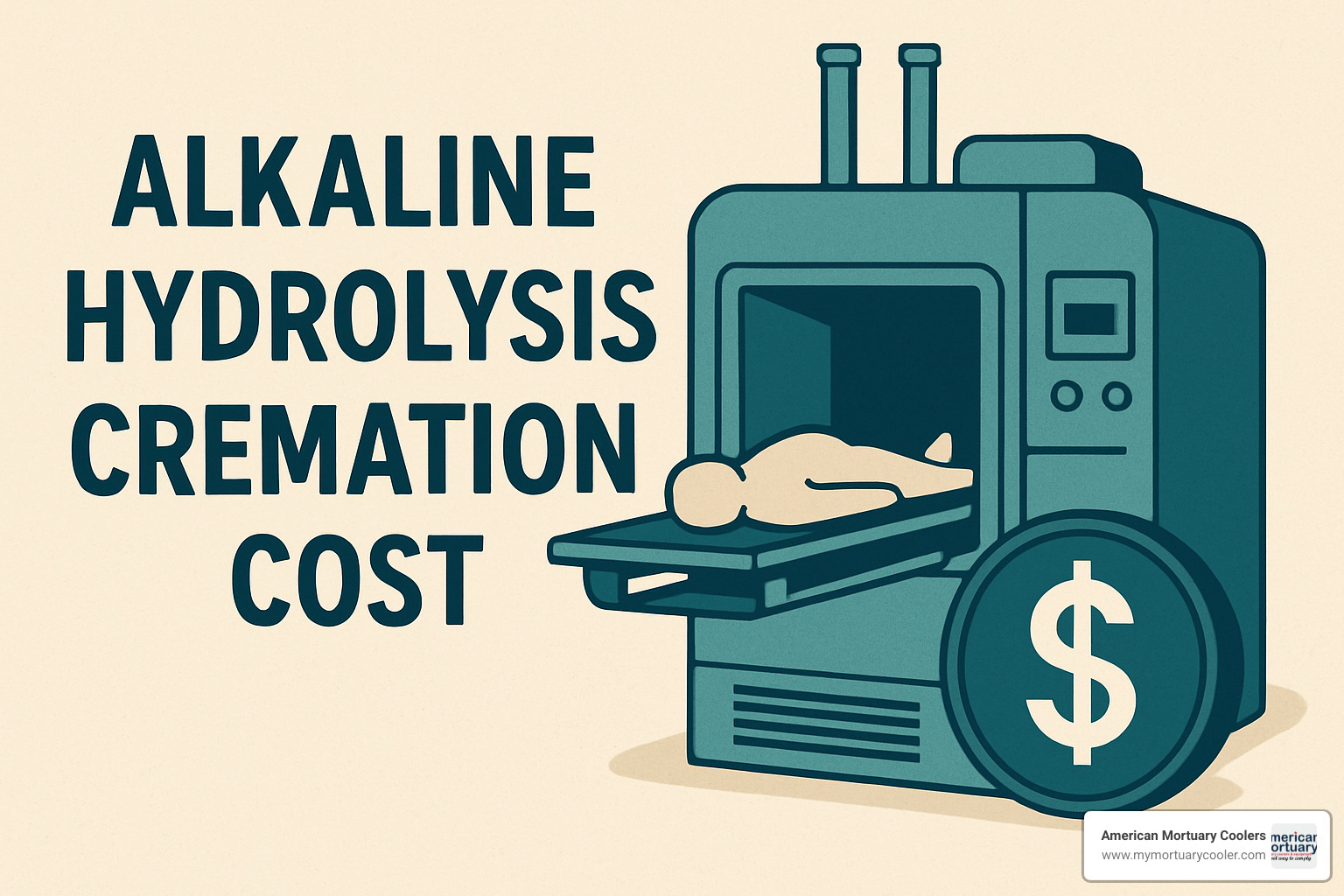
How much does alkaline hydrolysis cremation cost in 2025?
I've noticed alkaline hydrolysis cremation cost varies dramatically depending on where you live. The national median sits at $2,371 in 2025, but that doesn't tell the whole story.
If you're lucky enough to live in Missouri, you might pay as little as $995 at some facilities, with the state median hovering around $1,495. Washington residents also enjoy more affordable options, starting at $995 with a typical price of about $1,695.
The middle of the road states include Minnesota (median $2,250), Colorado ($2,395), and Oregon ($2,450).
Then we have the premium markets. California residents face a median price of $3,950 – that's a whopping 67% above the national median. Vermont currently holds the record for highest prices, reaching $4,616 in some locations.
For a real-world example, at City of Oaks Funeral Home in North Carolina, an alkaline hydrolysis cremation costs $2,640.59, while they offer direct flame cremation for $1,196.75 and immediate burial for $2,497.50.
Pet parents might be interested to know that aquamation for animals is much more budget-friendly, typically between $25-$500 depending on your pet's size. This price difference reflects the simpler regulations and smaller equipment needed for pet services.
Hidden fees that raise alkaline hydrolysis cremation cost
When I talk with families about alkaline hydrolysis cremation cost, I always emphasize the importance of looking beyond the base price. Several hidden fees can catch you by surprise if you're not careful.
Transportation charges can add up quickly, with many providers charging $2-$4 per mile once you're outside their standard service area (usually 25-30 miles). For families in rural communities or states where aquamation isn't yet available locally, this alone can add hundreds to your final bill.
Time matters too. If there's a delay before processing, refrigeration fees of $50-$100 per day may apply. And if you're hoping to witness the beginning of the process – something many families find meaningful – expect to pay an additional $100-$300 for this option.
Need the remains returned quickly? An expedited service fee of $200-$500 is standard. While a basic container for remains is typically included, upgrading to a special urn starts around $50 and can reach into the thousands for custom designs.
Most packages include 1-3 death certificates, but additional copies usually cost $10-$25 each. And like many services, weekend or holiday arrangements often come with premium rates.
My best advice? Always request an itemized price list before making arrangements, and get everything in writing. A reputable provider will be transparent about all potential costs upfront, helping you avoid any unpleasant surprises during an already difficult time.
What Drives Price? 4 Key Factors Families Should Know
When families explore green disposition options, they often wonder why the alkaline hydrolysis cremation cost runs higher than traditional methods. Understanding these factors not only helps make sense of the price tag but might even help you find more affordable options in your area.
High-Tech Equipment vs. Conventional Retort
The equipment investment represents the biggest factor driving alkaline hydrolysis cremation cost. While a traditional flame cremation machine (retort) costs around $130,000, aquamation equipment requires a much steeper investment—anywhere from $180,000 to $270,000.
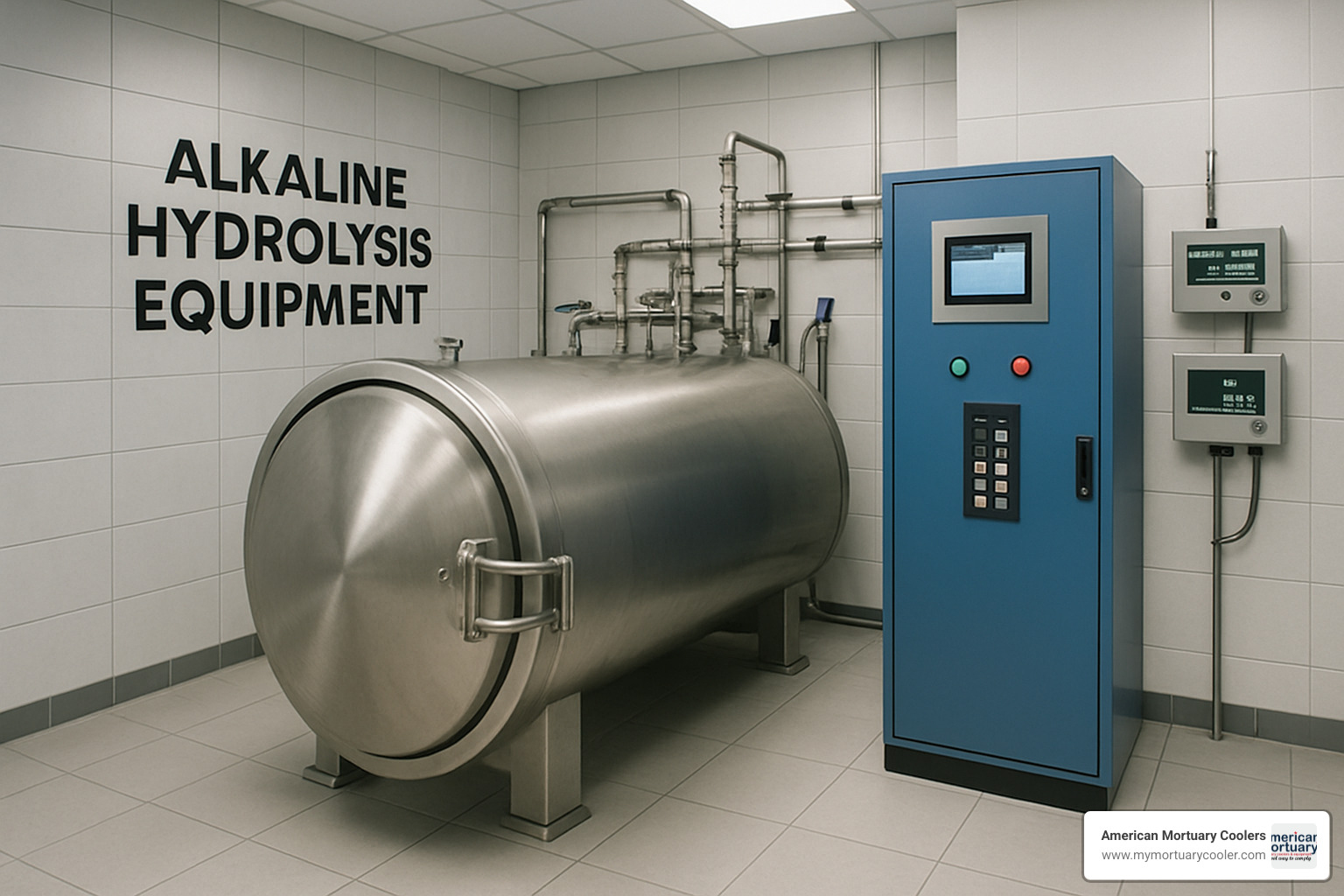
This substantial upfront cost gets spread across fewer cases since the technology is newer and still gaining acceptance. Plus, the process itself takes longer—6-8 hours compared to flame cremation's 2-3 hours—meaning each machine handles fewer cases per day.
The equipment itself is remarkably sophisticated. We're talking stainless steel pressure vessels, precision temperature controls, water circulation systems, and specialized bone processing equipment. It's essentially a high-tech spa for one final, gentle treatment.
Maintenance adds another layer to the cost equation. While aquamation equipment might need fewer repairs than flame cremation retorts (which regularly need their fire-resistant linings replaced), when something does go wrong, finding specialized technicians can be costly.
At American Mortuary Coolers, we've noticed that funeral homes investing in premium equipment with features like quick-cycle technology and remote diagnostics can sometimes offer better pricing. Their ability to process more cases with less downtime helps offset those initial costs.
Location, Competition & Legislation
Geography plays a surprisingly big role in what you'll pay for aquamation, creating dramatic price differences across the country.
State legality creates the first hurdle. While 28 states have legalized alkaline hydrolysis, only 17 actually have operational facilities. This creates "aquamation deserts" where families must pay extra transport costs to access the service.
Competition matters tremendously. In Minnesota and Colorado, where multiple providers operate, healthy competition keeps prices reasonable. But in states with just one provider, that facility essentially sets the market rate.
The regulatory burden varies wildly from state to state. Some jurisdictions treat aquamation much like flame cremation, while others impose additional requirements that drive up operational costs. These expenses inevitably get passed along to families.
Religious and industry opposition has slowed adoption in some regions. Traditional funeral industry groups have occasionally lobbied against alkaline hydrolysis, limiting competition and keeping prices higher than they might otherwise be.
Transport logistics add another layer of complexity. Some California providers, for instance, partner with facilities in Washington State, adding significant transportation costs to the final bill.
The most dramatic example? The difference between Missouri (median $1,495) and Vermont (up to $4,616)—a more than 300% price gap for essentially identical services, driven primarily by these regional factors.
For more insights into how these costs break down, check out The Price of Peace: Understanding Alkaline Hydrolysis Costs.
State Availability, Provider Search & Money-Saving Strategies
Looking for alkaline hydrolysis cremation services feels a bit like searching for a specialty coffee shop in the 1990s – they exist, but you need to know where to look. As of 2025, this green option has made significant progress but isn't universally available. While 28 states have legalized the process, only 17 actually have operational facilities.
You'll find working facilities in Alabama, California, Colorado, Florida, Georgia, Illinois, Maine, Minnesota, Missouri, Nevada, North Carolina, Ohio, Oregon, Texas, Utah, Vermont, and Washington. States like Connecticut, Idaho, Kansas, Maryland, Michigan, Nebraska, New Hampshire, Oklahoma, Tennessee, Wisconsin, and Wyoming have given the legal thumbs-up, but facilities remain limited or non-existent.
If you're wondering how to find a provider, don't worry – you're not alone in this search. The Cremation Association of North America (CANA) maintains a helpful member directory where you can specifically search for alkaline hydrolysis providers. State Funeral Directors Associations often keep lists of members offering specialized services like aquamation, and the Green Burial Council frequently provides information on eco-friendly disposition options.
Living in a state without aquamation access doesn't mean you're out of luck. Many families work with a local funeral home that partners with facilities in neighboring states. Some arrange direct transport to a nearby state with available services, though it's worth calculating whether the additional transport costs still make this financially viable compared to traditional options.
How to locate a licensed facility in your area
Finding the right provider for alkaline hydrolysis cremation is a bit like finding a good mechanic – asking the right questions makes all the difference. When you call funeral homes, be direct: "Do you offer water cremation or aquamation?" Then dig deeper. Ask whether they own their equipment or outsource to a third party (outsourcing often means markup). Inquire about their service radius without extra mileage fees and request an itemized breakdown of all costs.
Many funeral homes don't actually own aquamation equipment but work with facilities that do. This isn't necessarily a problem, but it typically adds to the base cost. Transparency matters – providers like City of Oaks Funeral Home in North Carolina offer clear, all-inclusive pricing ($2,640.59) with no-surprise guarantees.
I always recommend getting quotes from at least three different providers. You'll be surprised at the price variation, even within the same region. And here's an insider tip from our work at American Mortuary Coolers: independently owned funeral homes often offer more competitive pricing than corporate chains, which typically charge premium rates for this service.
Don't be shy about asking for price matching if you find a better rate elsewhere. Many providers will match competitors' prices to earn your business, especially if you're comparing similar service packages.
Cost-savings, Insurance & Pre-Need Options
Reducing the alkaline hydrolysis cremation cost doesn't mean cutting corners – it means being smart about available resources. Veterans can qualify for up to $300 toward cremation costs through VA death benefits, and Social Security offers a modest but helpful one-time death benefit of $255 to eligible surviving spouses or dependent children.
Many counties have indigent programs for low-income families, and various religious and community organizations provide funeral assistance. It never hurts to ask your spiritual community if they offer support for final arrangements.
Funeral providers themselves often have solutions to ease the financial burden. Some offer sliding scale pricing based on financial need, while many have interest-free payment plans. Package discounts can significantly reduce the total cost compared to selecting services individually.
Here's a money-saving strategy that's often overlooked: pre-planning. Pre-arranging and pre-paying can lock in current rates, protecting you from future price increases that have been outpacing inflation. Many providers even offer discounts for pre-payment.
Regarding insurance, most policies that cover cremation will also cover alkaline hydrolysis, but don't assume – verify this specifically with your provider. Pre-need funeral plans increasingly include alkaline hydrolysis options, often at guaranteed rates that won't change regardless of future price increases.
For the most budget-conscious, consider direct alkaline hydrolysis without additional services like viewing or memorial service. You can always hold a memorial gathering at a location meaningful to your loved one later, potentially saving thousands while still honoring their memory and environmental values.
At American Mortuary Coolers, we've helped funeral homes across the country implement this technology, and we're happy to recommend reputable providers in your region who offer fair pricing for these services. After all, saying goodbye shouldn't break the bank, even when choosing the greenest option.
Frequently Asked Questions about Alkaline Hydrolysis Cremation Cost
Is insurance covering aquamation and related expenses?
Good news for families considering aquamation – most life insurance policies that cover traditional cremation will also cover alkaline hydrolysis. However, there are some important details to keep in mind.
Since alkaline hydrolysis is legally classified as a form of cremation in states where it's permitted, it typically qualifies under standard cremation coverage. That said, older policies might not specifically mention "alkaline hydrolysis" or "aquamation" in their language. If you're unsure, a quick call to your insurance provider can clear things up.
One thing to watch for is whether your policy's benefit amount will fully cover the costs. Alkaline hydrolysis cremation cost tends to run $500-900 higher than flame cremation, and policies written years ago might not have kept pace with these newer technology costs.
Many forward-thinking funeral homes now offer pre-need plans specifically for alkaline hydrolysis. These plans are worth considering since they lock in current rates and often include price guarantees against future increases. Just be aware that newly purchased insurance policies typically have waiting periods before they'll cover funeral expenses.
When the time comes, most alkaline hydrolysis providers will work directly with insurance companies to process claims, which helps reduce immediate out-of-pocket expenses for families during an already difficult time.
Why is alkaline hydrolysis more expensive than flame cremation in most areas?
The higher alkaline hydrolysis cremation cost comes down to several practical factors that affect providers across the country.
First and foremost is the substantial equipment investment. Alkaline hydrolysis machines cost between $180,000-$270,000, compared to around $130,000 for traditional flame cremation equipment. Funeral homes need to recoup this higher investment through their service pricing.
The technology is also still relatively new in the funeral industry, creating a classic supply and demand situation. With operational facilities in only 17 states, there's simply limited availability, which naturally drives prices up in many regions.
Then there's the time factor. While a traditional cremation takes 2-3 hours, aquamation requires 6-8 hours to complete. This longer process time means each machine can handle fewer cases per day, increasing the per-case overhead costs.
"Our initial pricing was higher because we needed to cover our investment with lower volume," explained a Vermont funeral director I spoke with recently. "As demand has increased, we've been able to gradually reduce our prices."
Many providers also position alkaline hydrolysis as an eco-premium option, marketing it to environmentally conscious consumers who may be less price-sensitive. And when funeral homes don't own the equipment themselves and outsource to third-party facilities, each entity naturally adds its markup to the service.
At American Mortuary Coolers, we've seen these pricing dynamics evolve as the technology becomes more established, with costs gradually becoming more competitive in markets where multiple providers operate.
Do the ashes look different and does that affect urn cost or size?
Yes, alkaline hydrolysis produces remains that look noticeably different from flame cremation ashes, and this does impact your urn selection.
The most obvious difference is appearance. Aquamation produces a pure white, fine powder that resembles pristine beach sand. Traditional cremation, by contrast, yields gray, coarser remains with a more granular texture. This color difference occurs because aquamation doesn't involve combustion, so there's no carbon in the remains.
More importantly for planning purposes, alkaline hydrolysis cremation returns 20-30% more remains to families. This higher volume means you'll need a larger urn or container. Standard urns designed for flame cremation often won't accommodate the full volume from aquamation.
When selecting an urn, be sure to mention that the remains are from aquamation so your provider can recommend appropriately sized options. Some families choose to divide remains among multiple smaller urns rather than purchasing one larger container – this can be particularly meaningful when several family members wish to keep a portion of their loved one's remains.
The cost impact is relatively modest – larger urns typically cost 10-15% more than standard sizes. Interestingly, the finer texture of aquamation remains makes them ideal for certain memorial products like blown glass art or jewelry.
At American Mortuary Coolers, we've noticed more funeral homes stocking larger capacity urns specifically designed for alkaline hydrolysis remains. This is just one way the industry is adapting to meet the growing demand for this eco-friendly option.
Conclusion & Next Steps
As we've explored throughout this guide, alkaline hydrolysis cremation cost represents more than just a price point—it reflects an investment in sustainable end-of-life care that aligns with growing environmental consciousness. While the national average of $2,500 exceeds traditional cremation costs, many families find the environmental benefits and gentler process worth the premium.
The future looks promising for more affordable alkaline hydrolysis options. We're seeing positive trends as more states move beyond the current 28 where it's legal, additional facilities open beyond the 17 states with operational services, equipment costs decrease with technological advancement, and competition increases in established markets.
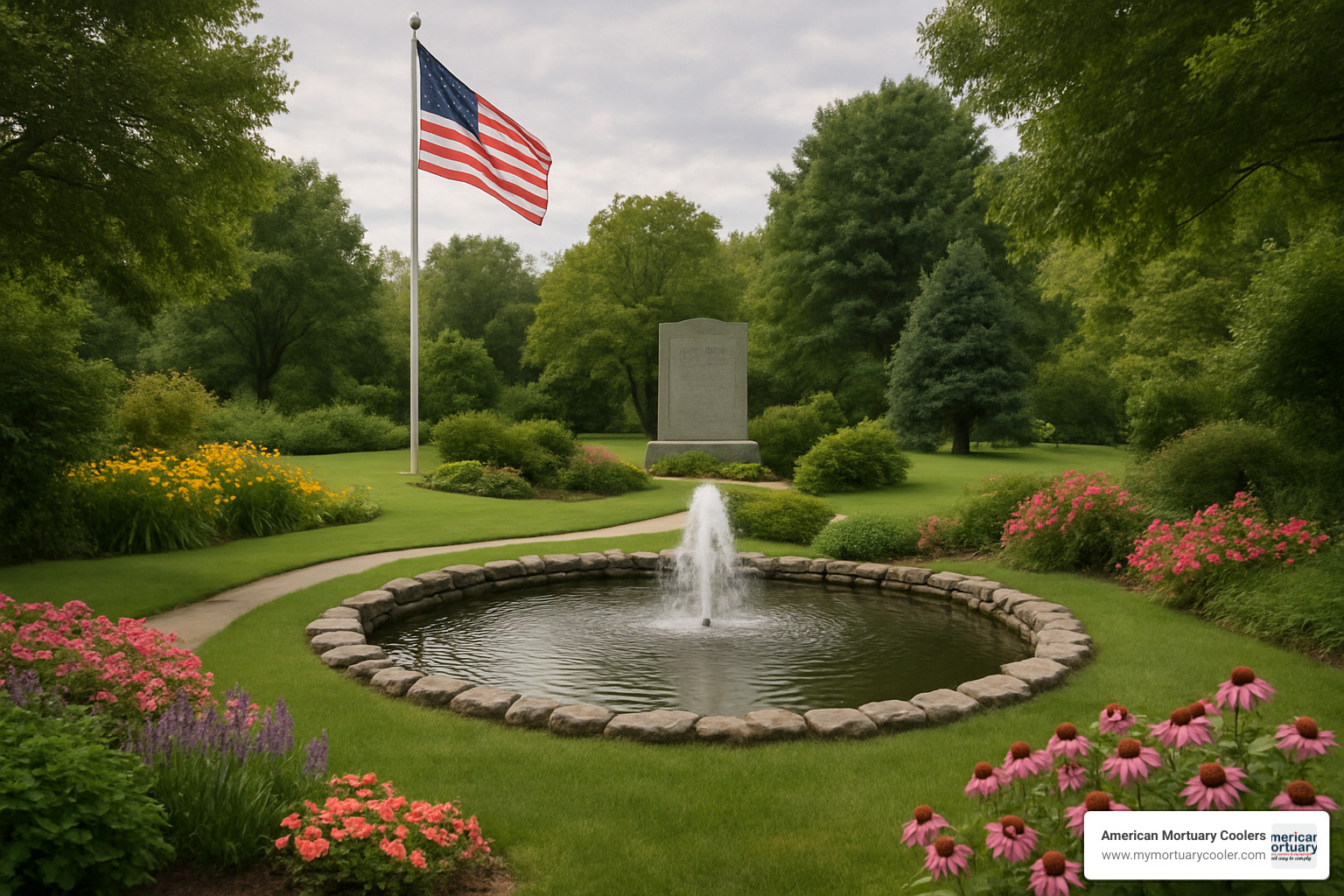
For families considering this eco-friendly option, I recommend starting with a few thoughtful steps. First, verify availability in your state using resources like the CANA directory or state funeral boards. This simple check can save you time and disappointment, especially if you live in an area where the service is still emerging.
Next, take time to compare providers by requesting itemized price lists from multiple facilities. The difference can be substantial—sometimes hundreds or even thousands of dollars for essentially the same service. While making these comparisons, don't forget to ask about hidden fees such as mileage charges, witnessing fees, or expedited service costs that might not appear on the basic price sheet.
Many families find peace of mind through pre-planning. This approach not only locks in current rates (protecting you from future price increases) but ensures your wishes are clearly documented. Your loved ones won't have to wonder if they're making the right choice during an already difficult time.
Don't overlook opportunities to explore financial assistance through veterans benefits, pre-need insurance, or payment plans. Many providers offer flexible options that can make this eco-friendly choice more accessible.
At American Mortuary Coolers, we're proud to support the funeral industry's transition toward more sustainable practices. Our team across our locations in Tennessee, Georgia, Illinois, and beyond provides custom mortuary equipment and guidance to funeral homes implementing alkaline hydrolysis technology. We've seen how this technology transforms both the environmental impact of death care and the experience of families seeking gentler alternatives.
Whether you're a family seeking information or a funeral professional considering adding this service, we hope this guide has provided valuable insight into the factors driving alkaline hydrolysis cremation cost and how to steer this increasingly popular option. For more detailed information about equipment and essential supplies, visit our aquamation equipment and essential supplies page.
By choosing alkaline hydrolysis, families not only honor their loved ones but also leave a positive environmental legacy—a final act of care for the planet we all share. After all, how we say goodbye reflects not just who we were, but what we valued and the world we hope to leave behind.


















